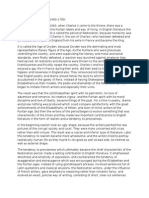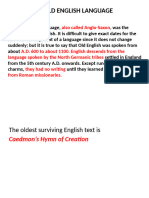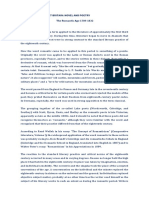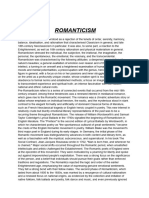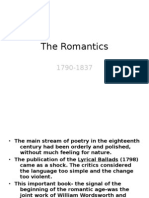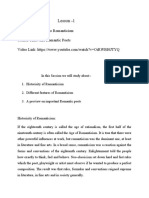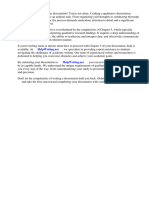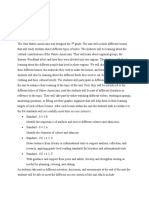0 ratings0% found this document useful (0 votes)
7 viewsліт країн
літ країн
Uploaded by
Віка Даценко1. The document discusses different periods of English literature from Old English to Neoclassical periods. It provides details on notable writers, works, and characteristics of each period.
2. It also discusses key concepts of Romanticism like a focus on emotions, nature, isolation and the common man. It outlines the differences between the 1st and 2nd generation of Romantic poets in their styles and themes.
3. Additionally, it summarizes Emily Bronte's novel Wuthering Heights, exploring different types of love depicted and how they lead to cycles of revenge. It also notes how Charles Dickens incorporated social issues in his novels.
Copyright:
© All Rights Reserved
Available Formats
Download as DOCX, PDF, TXT or read online from Scribd
літ країн
літ країн
Uploaded by
Віка Даценко0 ratings0% found this document useful (0 votes)
7 views1 page1. The document discusses different periods of English literature from Old English to Neoclassical periods. It provides details on notable writers, works, and characteristics of each period.
2. It also discusses key concepts of Romanticism like a focus on emotions, nature, isolation and the common man. It outlines the differences between the 1st and 2nd generation of Romantic poets in their styles and themes.
3. Additionally, it summarizes Emily Bronte's novel Wuthering Heights, exploring different types of love depicted and how they lead to cycles of revenge. It also notes how Charles Dickens incorporated social issues in his novels.
Copyright
© © All Rights Reserved
Available Formats
DOCX, PDF, TXT or read online from Scribd
Share this document
Did you find this document useful?
Is this content inappropriate?
1. The document discusses different periods of English literature from Old English to Neoclassical periods. It provides details on notable writers, works, and characteristics of each period.
2. It also discusses key concepts of Romanticism like a focus on emotions, nature, isolation and the common man. It outlines the differences between the 1st and 2nd generation of Romantic poets in their styles and themes.
3. Additionally, it summarizes Emily Bronte's novel Wuthering Heights, exploring different types of love depicted and how they lead to cycles of revenge. It also notes how Charles Dickens incorporated social issues in his novels.
Copyright:
© All Rights Reserved
Available Formats
Download as DOCX, PDF, TXT or read online from Scribd
Download as docx, pdf, or txt
0 ratings0% found this document useful (0 votes)
7 views1 pageліт країн
літ країн
Uploaded by
Віка Даценко1. The document discusses different periods of English literature from Old English to Neoclassical periods. It provides details on notable writers, works, and characteristics of each period.
2. It also discusses key concepts of Romanticism like a focus on emotions, nature, isolation and the common man. It outlines the differences between the 1st and 2nd generation of Romantic poets in their styles and themes.
3. Additionally, it summarizes Emily Bronte's novel Wuthering Heights, exploring different types of love depicted and how they lead to cycles of revenge. It also notes how Charles Dickens incorporated social issues in his novels.
Copyright:
© All Rights Reserved
Available Formats
Download as DOCX, PDF, TXT or read online from Scribd
Download as docx, pdf, or txt
You are on page 1of 1
1. Periodization of English literature. 4.
The portrayal of intense passions in Emily Bronte's "Wuthering
Old English Period (450–1066)Is also known as ‘The Anglo-Saxon 2. Aesthetic and philosophical principles of Romanticism. Two generations Height" (1846).
Period’ which starts from the mid of 4th century and goes up-to the 10th of English romantic poets. Wuthering Height is the only novel by Emily Bronte It was first published
century. The Angles and Saxons were the ancestors ˈænsestər of the English In romanticism, the “aesthetic”—most broadly that which concerns beauty in 1847.
race. They migrated to Britain around the 5th century after the fall of Western and art—is not just one aspect of human life or one branch of the humanistic Wuthering Heights explores a variety of kinds of love. Loves on display in
Roman Empire. The English Literature of this periods include, Genesis studies. Rather, if the romantic ideal is to materialize, aesthetics should the novel include Heathcliff and Catherine's all-consuming passion for each
ˈdʒenɪsɪs, Exodus ˈeksədəs, Husband’s message, The battle of Maldon etc. permeate and shape human life. other, which while noble in its purity is also terribly destructive. In contract,
Earlier, to understand the temperament of readers, writers would make use of Philosophical Romanticism holds that the universe is a single unified and the love between Catherine and Edgar is proper and civilized rather than
alteration rather than a rhyming ˈraɪmɪŋ| scheme. Moreover, some of the interconnected whole, and full of values, tendencies and life, not merely passionate. Theirs is a love of peace and comfort, a socially acceptable love,
famous writers of old English literature were Cynewulf and Caedmon. objective lifeless matter. but it can't stand in the way of Heathcliff and Catherine's more profound (and
Middle English period (1066–1500). They brought with their rich French Romanticism was a literary movement that began in the late 18th century, more violent) connection. The love between Cathy and Linton is a grotesque
culture and language. This period of literature is also termed as Anglo-French ending around the middle of the 19th century—although its influence continues exaggeration of that between Catherine and Edgar. While Catherine always
Literature. People like ‘Geoffrey Chaucer’ are amongst one of the most highly to this day. Marked by a focus on the individual (and the unique perspective of seems just a bit too strong for Edgar, Cathy and Linton's love is founded on
regarded poets within the period of 1342 to 1400 and were renowned for his a person, often guided by irrational, emotional impulses), a respect for nature Linton's weakness—Linton gets Cathy to love him by playing on her desire to
courtly love poetry, including the famous “Canterbury Tales”. “The House of and the primitive, and a celebration of the common man, Romanticism can be protect and mother him. Finally, there's the love between Cathy and Hareton,
Fame”, and ‘The Book of the Duchess’. Another significant work includes seen as a reaction to the huge changes in society that occurred during this which seems to balance the traits of the other loves on display. They have the
William Langland’s famous religious works like “Piers Plowman”. During this period, including the revolutions that burned through countries like France and passion of Catherine and Heathcliff without the destructiveness, and the
era of English Literature works like ‘Everyman’ was a noted Morality play of the United States, ushering in grand experiments in democracy. gentleness shared by Edgar and Catherine without the dullness or inequality in
the time and Miracle plays were taken from The Bible and were frequently The term Romanticism does not stem directly from the concept of love, but power.
performed in churches. rather from the French word romaunt (a romantic story told in verse). Nearly all of the action in Wuthering Heights results from one or another
The Renaissance Period (1500– 1660) Romanticism focused on emotions and the inner life of the writer, and often character's desire for revenge. The result are cycles of revenge that seem to
The Renaissance Period is also known as the ‘Elizabethan Period’ or used autobiographical material to inform the work or even provide a template endlessly repeat. Hindley takes revenge on Heathcliff for taking his place at
‘The Age of Shakespeare’. In-fact it is considered as the ‘Golden Age’ in the for it, unlike traditional literature at the time. Wuthering Heights by denying him an education, and in the process separates
history of English literature. After the Middle Ages in Europe came the Romanticism celebrated the primitive and elevated "regular people" as being Heathcliff and Catherine. Heathcliff then takes revenge upon Hindley by, first,
Renaissance which means revival |rɪˈvaɪvl| or rebirth. At times this period is deserving of celebration, which was an innovation at the time. Romanticism dispossessing Hindley of Wuthering Heights and by denying an education to
also referred to as ‘The Enlightenment Period’ in English Literature. Some also fixated on nature as a primordial force and encouraged the concept of Hareton, Hindley's son. Heathcliff also seeks revenge on Edgar for marrying
noted works of the time are works of ‘John Donne’ also played a greater role in isolation as necessary for spiritual and artistic development. Catherine by marrying Cathy to Linton Yet while Heathcliff's revenge is
metaphysical ˌmetəˈfɪzɪkl poetry and beautiful sonnets of the Golden age. Romantic literature is marked by six primary principles: celebration of nature, effective, it seems to bring him little joy. Late in the novel, Cathy sees this, and
However, Literary Dramas have played a crucial role in making this age focus on the individual and spirituality, celebration of isolation and tells Heathcliff that her revenge on him, no matter how miserable he makes
‘Golden’. The first comedy play in this age was ‘Ralph Roister Doister’ by melancholy, interest in the common man, idealization of women, and her, is to know that he, Heathcliff, is more miserable. And it is instructive that
Nicholas Udall. personification and pathetic fallacy. only when Heathcliff loses his desire for revenge is he able to finally reconnect
Classics like ‘Hamlet’, ‘King Lear’, ‘Othello’ and ‘Julius Ceasar’ to ‘A 1st generation: Wordsworth and Coleridge. with Catherine in death, and to allow Cathy and Hareton, who are so similar to
Midsummer Night’s Dream’, ‘As You Like It’ and ‘Romeo and Juliet’ were They shared the same ideas of poetry and imagination but the subject of their Heathcliff and Catherine, to find love and marry.
some of the most important contributions made by William Shakespeare. His poetry was very different. Wordsworth was more didactic, instead Coleridge’s
contribution was so immense that this age is also referred as ‘The Age of imagination moved in a fantastical or dream-like world.They were in favour of
Shakespeare’. Other notable writers of the Golden age include writers like John French Revolution. Their poems were easier to be read: the language is
Milton, John Webster, Thomas Kyd, George Peele, Ben Jonson, etc. easy.They wrote songs and ballads.They used imagination.
The Neoclassical Period (1660–1798) 2nd generation: Byron, Shelley and Keats.
The period from 1660 to 1700’s is called the Restoration Period because They wrote more classical poems like odes, sonnnets and elegies. They
monarchy was restored in England. Charles II came returned to England from abandoned the popular genre in favour of a more traditional one.In their poems
his exile ˈeksaɪl in France and became the King. there is a strong presence of arcaisms.The language is difficult, elevated and
During the mid 18th and late 18th century, novels were introduced to the raffinate.They moved to more profetic themes and considered themselves like
world. Daniel Defoe experimented with the prose narrative and wrote a novel profets: they wanted to bring the truth to the menkind.
called ‘Robinson Crusoe’. He is considered as one of the most significant 3. Social issues in Charles Dickens' novels.
writers who introduced novel writing to the literary world. In prose writing, Charles Dickens, a renowned Victorian author, often incorporated social issues
Richard Steel and Jonathan Swift are also some of the popular names in prose and criticisms of the 19th-century society in his novels. His works shed light on
writing. various societal problems, highlighting the plight of the poor, the harsh realities
The Modern Period (1901-1945) of industrialization, the disparities in wealth and class, and the need for social
This period started in the 20th century. In this period, the writer’s reforms:Poverty and Social Injustice: Dickens frequently depicted the harsh
approach towards life and its problems that was followed in The Victorian Era living conditions and extreme poverty experienced by many characters in his
was opposed. A new value system was introduced by the writers and was also novels. Works such as "Oliver Twist," "David Copperfield," and "Hard Times"
visible in their writing style and work. The main reason for the sift was the lack reveal the disparities between the rich and the poor, the exploitation of
of self-interrogation and absence of scientific thoughts in the Victorian Writers. workers, and the corrupt systems that perpetuated social inequality.Child Labor
The Few important writers who were responsible for this change in mind set and Education: Dickens exposed the plight of child laborers and emphasized
were writers like Engles, Karl Marx, Morris and many more. the importance of education for all children. In "Oliver Twist," he portrays the
The Contemporary Period (1945 – Present) exploitation of young orphans forced to work under deplorable conditions.
History of English Literature (Literary Periods and Movements) Through characters like David Copperfield and Pip in "Great Expectations," he
After the second World War there was a major shift in English highlights the challenges faced by children striving for education and self-
Literature. Which was caused by the arrival of mass mediums like newspapers, improvement.Industrialization and Its Effects: Dickens explored the
radio, TV and films. The writers of this period experiment more than ever consequences of rapid industrialization on society. In novels like "Hard
because they have access to more information than writers of the earlier Times," he criticized the mechanization of human life, the dehumanizing
periods. The information was used by the writers to explore more aspects of effects of factory work, and the loss of compassion and imagination in an
human emotions and nature. Some notable writers of this era are John Wain, increasingly materialistic world.Class Struggles and Social Mobility: Dickens
William Golding, Yuval Noah Harari, Toni Morrison, Philip Roth, and many examined the rigid class system of Victorian England, focusing on the
more. struggles faced by individuals seeking upward social mobility. Characters like
Pip in "Great Expectations" and Esther Summerson in "Bleak House" grapple
with their desires to rise above their social standing, highlighting the
limitations and prejudices imposed by the class structure..Gender Inequality: In
"Bleak House" and "Hard Times," he addressed the limitations placed on
women, their lack of agency, and the importance of empowering women
through education and independence. His works played a significant role in
raising awareness and encouraging reforms in Victorian society.
You might also like
- Periods of British LiteratureDocument4 pagesPeriods of British Literaturepierrette195% (38)
- Smmffiffiw Kffiffi: Yff by Hffivfn Itr"T, NLT IDocument1 pageSmmffiffiw Kffiffi: Yff by Hffivfn Itr"T, NLT ISam AelNo ratings yet
- Restoration Periode LiteratureDocument3 pagesRestoration Periode LiteratureSulfa RaisNo ratings yet
- РОЗМОВНЕDocument81 pagesРОЗМОВНЕДіана ГабрикевичNo ratings yet
- Romanticism NotesDocument4 pagesRomanticism NotessbahlemalekaNo ratings yet
- 01-02 Gothic, Literature, Themes, Motives HandoutDocument15 pages01-02 Gothic, Literature, Themes, Motives HandoutDaniraKucevic100% (1)
- PDocument10 pagesPChiàCalapristiNo ratings yet
- Cavlier and Puritan Literature 1600-1660Document5 pagesCavlier and Puritan Literature 1600-1660Інна МалікNo ratings yet
- Romanticism: Representative Authors Jane Austen (1775-1817)Document3 pagesRomanticism: Representative Authors Jane Austen (1775-1817)Célia ZENNOUCHENo ratings yet
- The RestorationDocument7 pagesThe RestorationAbhishek Singh50% (2)
- Outline of English LiteratureDocument44 pagesOutline of English LiteraturepelobikkNo ratings yet
- LeituraDocument25 pagesLeituraedenymahessemahesseNo ratings yet
- Chapter 1Document49 pagesChapter 1SARWALNo ratings yet
- Drama Prose PoetryDocument21 pagesDrama Prose PoetryJimmi KhanNo ratings yet
- The Restoration and The Eighteenth Century 1660Document11 pagesThe Restoration and The Eighteenth Century 1660Fauzan 11sNo ratings yet
- Romanticism in Great Britain PDFDocument7 pagesRomanticism in Great Britain PDFJherlein Ayala ValderramaNo ratings yet
- Augustan PeriodDocument13 pagesAugustan PeriodParlindungan Pardede100% (3)
- The Romantic PeriodDocument20 pagesThe Romantic Periodnadieh_baderkhani100% (1)
- Introduction To LiteratureDocument2 pagesIntroduction To LiteratureMarini DondoNo ratings yet
- Romanticism in American LiteratureDocument2 pagesRomanticism in American LiteraturesunnysNo ratings yet
- Rizal Technological University College of Education English DepartmentDocument23 pagesRizal Technological University College of Education English DepartmentMaynard LontocNo ratings yet
- The Renaissance and PoetryDocument5 pagesThe Renaissance and PoetryMadonna Seixas100% (1)
- RomanticismDocument3 pagesRomanticismAditya SharmaNo ratings yet
- Lesson 2 - The History of English LiteratureDocument26 pagesLesson 2 - The History of English LiteratureLeane MaeNo ratings yet
- Literature Bagian CacaDocument4 pagesLiterature Bagian CacaAnnisa FitrianiNo ratings yet
- Romanticism: Pre-Romantic PeriodDocument5 pagesRomanticism: Pre-Romantic PeriodRamsha TjwNo ratings yet
- The Romantic PeriodDocument3 pagesThe Romantic Periodanon_485858902No ratings yet
- The Puritan Movement. in Its Broadest Sense The Puritan Movement May Be Regarded As ADocument11 pagesThe Puritan Movement. in Its Broadest Sense The Puritan Movement May Be Regarded As AKamala OinamNo ratings yet
- A Very Short History of English Lit..Document18 pagesA Very Short History of English Lit..Dr-Mubashar Altaf100% (3)
- The Victorian AgeDocument8 pagesThe Victorian Agefrancescacardamone05No ratings yet
- Untitled Document - EditedDocument9 pagesUntitled Document - EditedAhmed Ali JanNo ratings yet
- History of English Literature: Unit-I Chaucer and Elizabethan AgeDocument40 pagesHistory of English Literature: Unit-I Chaucer and Elizabethan Agevignesh100% (1)
- Poetry AssignmentDocument11 pagesPoetry Assignmentarshirinu1No ratings yet
- LitraDocument4 pagesLitraartchuuudNo ratings yet
- Romanticism in LiteratureDocument37 pagesRomanticism in LiteratureKristian PopovNo ratings yet
- ІЗЛ 2 курс Lecture 4 1 The Romantic Period of Eng LitDocument6 pagesІЗЛ 2 курс Lecture 4 1 The Romantic Period of Eng Litpoikan.tania2No ratings yet
- IntroduNature in Walt Whitman's PoetryctionDocument19 pagesIntroduNature in Walt Whitman's PoetryctionShowket Ibraheem100% (1)
- Historical Background of Romantic AgeDocument16 pagesHistorical Background of Romantic AgeRashmi Chandrashekar50% (4)
- First Half of The 18th CenturyDocument8 pagesFirst Half of The 18th Centuryklau2No ratings yet
- The Romantic AgeDocument13 pagesThe Romantic Agenn2449588No ratings yet
- The RomanticsDocument15 pagesThe RomanticsVEEVOO*No ratings yet
- The Romantic Period Was Largely A Reaction Against The Ideology of The Enlightenment Period That Dominated Much of European PhilosophyDocument4 pagesThe Romantic Period Was Largely A Reaction Against The Ideology of The Enlightenment Period That Dominated Much of European PhilosophyratihNo ratings yet
- Unit 2 Literatura Inglesa II.2 DEFINITIVODocument31 pagesUnit 2 Literatura Inglesa II.2 DEFINITIVOCristina G.MarichalNo ratings yet
- 1.romanticism - Oxford ReferenceDocument3 pages1.romanticism - Oxford Referencedanai nariNo ratings yet
- History of English LiteratureDocument3 pagesHistory of English Literaturechristopher sloanNo ratings yet
- English LiteratureDocument46 pagesEnglish LiteratureBetea RebecaNo ratings yet
- 1 Literary Periods of British and American Literature 1 1Document6 pages1 Literary Periods of British and American Literature 1 1ikramNo ratings yet
- What Is Novel.Document79 pagesWhat Is Novel.bariscem100% (1)
- Literary Period - Restoration - 8174079 - 2022 - 08 - 22 - 11 - 17Document5 pagesLiterary Period - Restoration - 8174079 - 2022 - 08 - 22 - 11 - 17Paras BijarniyaNo ratings yet
- From Chaucer To Renaissance English Literature Complete Study Guide Notes by The Literary LighthouseDocument10 pagesFrom Chaucer To Renaissance English Literature Complete Study Guide Notes by The Literary LighthouseCanon MaqsoodNo ratings yet
- EnglishRomanticPoetry PDFDocument24 pagesEnglishRomanticPoetry PDFDiana MaryaNo ratings yet
- Medieval RomanceDocument1 pageMedieval Romancelorenzoberardone1223333No ratings yet
- Week-1 Lesson - 1: Topic: Introduction To Romanticism Course Title: The Romantic PoetsDocument9 pagesWeek-1 Lesson - 1: Topic: Introduction To Romanticism Course Title: The Romantic PoetsMd. Salman Manzoor ArnobNo ratings yet
- Tugas SelDocument29 pagesTugas Selvavasayang22No ratings yet
- One novel...a lot of Novels: brief history of the novel in English languageFrom EverandOne novel...a lot of Novels: brief history of the novel in English languageNo ratings yet
- A History of English Romanticism in the Nineteenth CenturyFrom EverandA History of English Romanticism in the Nineteenth CenturyNo ratings yet
- Percy Bysshe Shelley Complete Works – World’s Best Collection: 150+ Works - All Poetry, Poems, Rarities Plus Biography and BonusesFrom EverandPercy Bysshe Shelley Complete Works – World’s Best Collection: 150+ Works - All Poetry, Poems, Rarities Plus Biography and BonusesNo ratings yet
- Books and AuthorsDocument7 pagesBooks and AuthorsYazur GargNo ratings yet
- Literary Aptitude: C) William ShakespeareDocument10 pagesLiterary Aptitude: C) William ShakespeareSuryansh jainNo ratings yet
- William Blake Lesson PlanDocument8 pagesWilliam Blake Lesson Planapi-530119088No ratings yet
- 21stCL Q1 M6Document16 pages21stCL Q1 M6Anna Marie AgravanteNo ratings yet
- Chapter 5 Dissertation QualitativeDocument7 pagesChapter 5 Dissertation QualitativeWriteMyApaPaperSouthBend100% (1)
- Unit RationaleDocument2 pagesUnit Rationaleapi-654006591No ratings yet
- Essay On American HistoryDocument7 pagesEssay On American Historytycheknbf100% (2)
- Poets and PancakesDocument15 pagesPoets and PancakesKarma Not OfficialNo ratings yet
- 1.Kihe-diploma-On The Way To K ADocument3 pages1.Kihe-diploma-On The Way To K ACA Govinda RajuNo ratings yet
- MY LAST DUCHESS by ROBERT BROWNINGDocument6 pagesMY LAST DUCHESS by ROBERT BROWNINGKenny WaggyNo ratings yet
- Malifaux SpreadsheetDocument4 pagesMalifaux SpreadsheetBenRussellJonesNo ratings yet
- Greece, But Also in Asia Minor, Magna Grecia: Literatures of The WorldDocument5 pagesGreece, But Also in Asia Minor, Magna Grecia: Literatures of The WorldAkemi KawamuraNo ratings yet
- Various Dimensions of Philippine Literary From Pre - Colonial To ContemporaryDocument27 pagesVarious Dimensions of Philippine Literary From Pre - Colonial To ContemporaryPrincess VelascoNo ratings yet
- Spanish FinalDocument3 pagesSpanish Finalapi-458577579No ratings yet
- Arnold Function of CriticismDocument9 pagesArnold Function of CriticismM Shakeel Anjum JuttNo ratings yet
- 101 104學測英文 PDFDocument21 pages101 104學測英文 PDFplutoNo ratings yet
- Course Outline. Contemporary, Popular & Emerging Lit. LatestDocument3 pagesCourse Outline. Contemporary, Popular & Emerging Lit. Latestnev_benitoNo ratings yet
- Structuralism Involving A Fundamental Rethinking Surrounding Language, Text, The World andDocument12 pagesStructuralism Involving A Fundamental Rethinking Surrounding Language, Text, The World andPintu BaralNo ratings yet
- A Nation's StrengthDocument2 pagesA Nation's StrengthR.K. Afrin100% (1)
- 2023 11. 2. YAZILIDocument4 pages2023 11. 2. YAZILIrazuberimeiNo ratings yet
- Kalatehseifary MasoomehDocument127 pagesKalatehseifary Masoomehguava701aNo ratings yet
- WIND Taniya SharmaDocument15 pagesWIND Taniya SharmaSarkar JiNo ratings yet
- NisthurataDocument1 pageNisthurataRungiaNo ratings yet
- Act Sample EssayDocument6 pagesAct Sample Essayohhxiwwhd100% (2)
- Annabel Lee Poety Analysis PaperDocument9 pagesAnnabel Lee Poety Analysis PaperNody tamerNo ratings yet
- Structures and Elements of ProseDocument19 pagesStructures and Elements of ProseJohn Lexter Magnaye100% (2)
- Story Time Fun Activities Games - 7584Document1 pageStory Time Fun Activities Games - 7584HarmonyParkerNo ratings yet
- Literatura Norteamericana IIDocument2 pagesLiteratura Norteamericana IIMarga Vives VinentNo ratings yet
- Poem AnalysisDocument12 pagesPoem AnalysisHaidelyn CapistranoNo ratings yet









